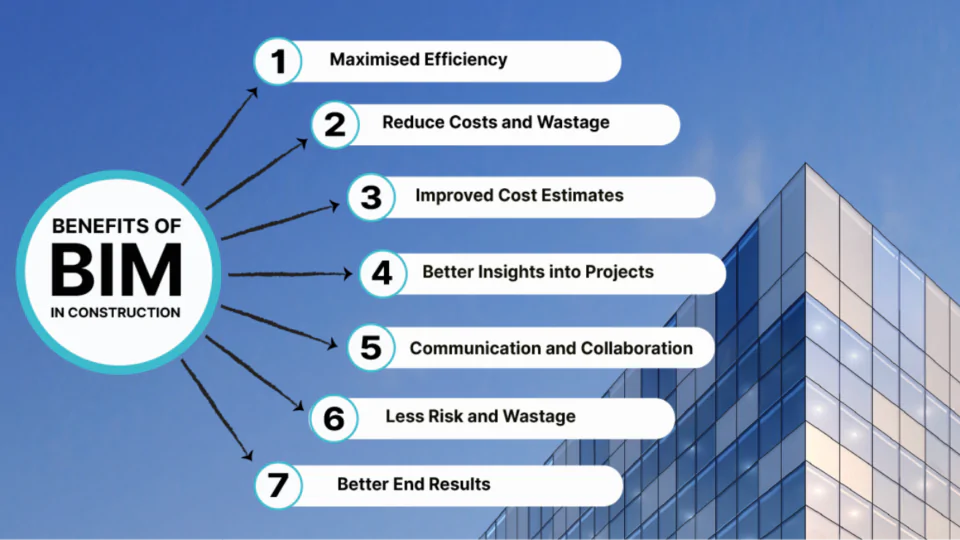Global BIM Adoption around the world.

Table of Contents
“We’ve seen the future, and it’s BIM shaped”
BIM or Building Information Modelling or Building Information Management is a cohesive system that creates a collaborative medium that allows professionals in the AEC industry to build and design within a single 3D model. BIM adoption not only helps in establishing a common interface but also assists with operation and management through data.
Emerging as one of the most promising developments in the Architecture, Engineering and Construction (AEC) industry, BIM is a prominently used platform in many leading countries. BIM is used to avoid mishaps and implement better project management, avoiding unsolicited project failures. When a similar concept is applied to bridges, this process is termed Bridge Information Modelling (BrIM). Let us now move on to discussing the origin of the adoption of BIM on a global scale.
This guide explores global BIM adoption, its rise, timeline, key drivers, benefits, challenges, and country-wise adoption trends. It breaks down how BIM is transforming workflows, boosting efficiency, and reshaping AEC standards worldwide. Ideal for architects, engineers, students, and firms seeking to understand worldwide BIM mandates and why now is the smartest time to upskill in BIM.
Also Read: Top 7 Places to Learn BIM (Building Information Modelling) in India
The Rise of BIM
The rise of BIM can be traced back to its early innovations in the 1960s. It evolved from basic CAD systems into a powerful tool that reshaped the AEC industry, enhancing collaboration and efficiency.
To understand the timeline of BIM adoption around the world, let us go back to the dawn of computing days. It was the year 1962 when Douglas C. Englebart painted a visionary image of an architect from the future in his paper "Augmenting Human Intellect". In a world that was unknown to BIM systems, Computer-aided Design (CAD) and Computer-aided Manufacturing (CAM) emerged as novel technologies in the '60s. Nobody fathomed the technological force CAD and CAM were capable of and where it would lead us.
The contributions of Christopher Alexander influenced an early school of programming. While these systems were well-planned, they lacked a graphical platform to interact with a Building Model. This further laid focus on accelerating the use of visualisation in conceptual frameworks.

The first commercial software was developed by Dr. Patrick J. Hanratty, later growing into a significant milestone in CAM. He later created DAC (Design Automated by Computer) in 1961. DAC later paved the way for creating a CAD/CAM system by using interactive graphics.
“Never generate anything closely coupled to a specific architecture. And make sure you keep things open to communicate with other systems, even your competitors.” - Dr. Patrick J. Hanratty
The Timeline:
1957: First Computer-aided machining software (CAM)
1963: Sketchpad, CAD with graphical user interface
1975: BDS (Building Description System)
1977: GLIDE (Graphical Language for Interactive Design)
1982: 2D CAD
1984: Radar CH
1985: Vectorworks
1986: RUCAPS (Really Universal Computer-Aided Production System)
1987: ArchiCAD
1988: ENGINEER/Pro
1992: Building Information Model - officially
1993: Building Design Advisor
1994: miniCAD
1995: International Foundation Class (IFC) file format
1997: ArchiCAD's Teamwork
1999: Onuma
2000: Revit
2001: NavisWorks
2002: Autodesk takes over Revit
2003: Generative Components
2004: Revit 6 update
2006: Digital Project
2007: Autodesk takes over NavisWorks
2008: Parametricist Manifesto
2012: formit
Understanding BIM and its Benefits

BIM streamlines project workflows by integrating design, scheduling, and cost management into a unified model. It enhances collaboration, reduces errors, and increases sustainability in construction.
People keep talking about making data management better and making better collaborative approaches that can lead to more streamlined workflows. But does anyone talk about how and the benefits of BIM?
Well, BIM answers your question.
Here are a few reasons why you should switch to BIM technology:
1. Reduced Risks and Costs
We all understand the hassle of reworking that comes with potential disagreements during the construction phase, which can consume both time and money. BIM-based budget estimation helps in avoiding cost overruns which is a huge red flag when it comes to working through traditional methods. 4D simulations help BIM adopters to identify the challenges and solve them efficiently, saving time and money!
2. Aims at higher sustainability
With the increasing pollution and the rage of waste, shapeshifting towards sustainable practices is the need of the hour. BIM technology helps us provide a digital model that not only identifies potential issues but maps sustainable methods and materials to make construction better. This in turn can help us reduce waste and the environment as a domino effect.
3. Better Productivity, Better Efficiency
BIM enables stakeholders to view and interact in the same virtual model of the building along with AEC professionals generating 2D drawings from 3D models that optimises time and accuracy. BIM also helps in creating prototypes that help in charting out patterns in different designs and construction scenarios.
4. Enhanced Communication and Collaboration
BIM adoption comes into the picture with a single integrated model that is open to collaboration and makes it easier for the team to find and share relevant data. An interface like this helps in an efficient collaboration that leads to avoiding potential risks and improving communication between project members. This bags in some time and helps with improving efficiency at the same time!
Gradual Adoption of BIM
The adoption of BIM should be phased, beginning with assessing capabilities, setting realistic goals, and progressively training teams to integrate BIM into projects for seamless implementation.
BIM adoption should be a gradual and steady process for any organisation. Let’s check out the steps an organisation can follow to ensure this -
1. Evaluating current capabilities
The very first step towards adopting BIM is assessing the current tools, skills and resources available within the organisation. Evaluate how BIM can be integrated in your current wireframe with minimal interruptions.
2. Set achievable goals
Outline realistic objectives for BIM adoption that align with your organisation’s broader objective and the skillset of the resources. One of the best approach to it is beginning with 3D modelling for comparatively smaller projects and gradually moving onto more complex BIM features.
3. Skill development
Training of the resource is as crucial as BIM requires critical skillset and the staff must be equipped with the basic understanding of BIM.
Integrate BIM - Incorporate BIM functionalities gradually into your organisation’s existing projects. Begin with a project that is manageable and with the least risk involved. This pilot project will help you in integrating BIM with existing workflows gradually.
4. Continuous evaluation
Consistently evaluate the outcomes of BIM adoption and adapt to the necessary improvements needed. To completely leverage the benefits of BIM, adaption is the key.
The Global Wave of BIM Adoption around the world

The global adoption of BIM is expanding rapidly, with countries like the US, UK, and Singapore leading the way. Government mandates and public sector projects are the main drivers of this adoption.
The adoption of BIM cannot be left unnoticed, and while many regions are making BIM a mandatory practice, some are on the course of action. Many nations like the US, UK, China, Singapore, South Korea, France, etc. have started using BIM for projects in the public sector. The US is one of the first nations to adopt this technology within several public sector organisations like the US Army Corps of Engineers, the General Service Administration, etc. Countries from Europe are also active users of BIM on a large scale. With the public sector playing a primary role in BIM adoption practices, the UK government is all set to acquire BIM Level 2 by 2016. The practice of implementing applications of BIM has been increasing globally with non-profit agencies and government organisations diving into diverse BIM solutions and standards.
Also Read: Top 20 BIM Consulting Firms in India & the USA to look for in 2026
Factors Affecting BIM Adoption around the world
The adoption of BIM is influenced by perceived benefits, external pressures like government mandates, and internal factors such as readiness and available resources.
The challenges in the Construction sector are multifaceted and multiple concepts are on their way to making it easier along with establishing interfaces that make collaboration, design processes, and visualisation more efficient. According to studies, three major factors influence the adoption of BIM in the AEC industry:
1. Perceived Benefit:
Recognizing the gaps, many BIM users have perceived quality improvement as one of the major benefits. Other advancements include improved access to data, better collaboration, and improvement in accuracy.
2. External Forces:
To stay relevant, one has to stay a step ahead and keep an eye on their competitors and focus on better interfaces. This is where external forces like competitors, collaborators, etc. kick in.
There are 3 factors to consider in this category :
- Influences from the competitors
- Influences from the collaborative parties
- The objective of BIM adoption around the world is to remain relevant and ahead of their competition.
3. Internal readiness:
This covers the internal agility of the team and focuses on the attitude of the management, the financial cost of BIM, training hours, etc. According to surveys conducted, a major part of any adopter's firm supports the usage of BIM and upskilling internally.
Also Read: How Can BIM Effectively Help End Corruption in the AEC Industry?
The Impact of BIM adoption: A piece of inspiration to get you started
Real-world examples like the Dongdaemun Design Park & Plaza show how BIM can enhance design processes, improve collaboration, and manage complex projects effectively.
The wave of BIM is steadily colliding with traditional methods, and we are walking the aspirational lane in the construction industry. One such impactful example is the Dongdaemun Design Park & Plaza in Seoul, designed by Zaha Hadid Architects.
Being the first public project in Korea to use 3D BIM, the project has marked its historic value along with stimulating the thought of switching to BIM technology. If we traverse through the design process, it is noticeable that every design requirement taken into consideration involves behavioural patterns and social interactions around the building fabric. These further stitched the framework of design, crafting out derivatives of the project like programmatic requirements, engineering, and spatial context.
Zaha Hadid is known for her complex designs and her meandering around parametricism. As much as it looks visually appealing, the skeleton behind it can be intense and complicated to understand, which might lead to creating unclear communication and several unrecorded gaps. Challenges like mismanaged communication between subcontractors, labour management groups, MEP specialists, and other collaborators spread across the globe. The fabrication of the building envelope with 45,000 unique aluminium panels in the design was another challenge to be dealt with. The urgency of implementing applications of BIM and creating a streamlined design workflow and efficiency in building management led to the much-needed BIM adoption to complete the project successfully.
Also Read: 20 Popular BIM Companies Around the World for Architects and Engineers
Conclusion
The AEC sector is struggling to foster in settings, and while it is making diligent efforts to flourish with the current shapeshifting, some gaps need to be identified and filled. One such bridge is BIM. With many sectors going BIM with government agencies and nonprofit organisations in recent years, implementing applications of BIM are only gearing up. As we move ahead, we are only looking at better management, optimised workflows, and efficiency in the AEC industry. We are on our way to embarking upon this journey and making BIM adoption around the world a mandatory practice!
So, Let's get BIM-ming!
Interested in learning more about BIM Modeling? Here’s something that might interest you. Novatr offers you a course in BIM Professional Course for Architects that will help you understand computation in different design fields with industry workflows, advanced tools for a concrete foundation in computational design. Learn high-performance computational BIM and building analysis via a live industry project. Bag opportunities along with professional certification, endless career possibilities and upskilling.
FAQs
1. What is the BIM adoption strategy?
The BIM adoption strategy involves evaluating current resources, defining achievable goals, upskilling teams, and gradually integrating BIM into workflows. It’s crucial to start with basic features, like 3D modeling, and progressively move to advanced capabilities, ensuring proper staff training and continuous evaluation for optimal results in the organization’s projects.
2. What is the global standard for BIM?
The global standard for BIM is the ISO 19650 series. This standard outlines the principles and requirements for managing BIM data, ensuring efficient and consistent project delivery. It provides guidelines for organizing information and collaboration throughout the project lifecycle, aiming to promote consistency, reduce errors, and streamline processes across industries worldwide.
3. Will AI replace BIM?
AI will not replace BIM but rather enhance it. AI technologies complement BIM by automating repetitive tasks, analyzing large datasets, and improving decision-making. While BIM manages design and construction processes, AI supports BIM through predictive insights, improving efficiency, accuracy, and overall performance in construction projects.
4. What is a real-world example of BIM?
A notable real-world example of BIM is the London Crossrail Project. BIM technology enabled the project team to integrate design, construction, and management phases, reducing errors and improving coordination across multiple stakeholders. The use of BIM allowed for efficient planning, scheduling, and budgeting, ensuring the project was delivered on time and within budget.
5. What is 3D, 4D, 5D, 6D, and 7D in BIM?
In BIM, 3D refers to the design model, which represents the structure’s physical components. 4D adds time (scheduling) to visualize the construction sequence. 5D incorporates cost estimation, helping with budgeting. 6D focuses on sustainability, optimizing energy performance, while 7D involves facilities management, allowing for long-term operation and maintenance of the building.

 Thanks for connecting!
Thanks for connecting!


.png)


-1.png)

.png)


